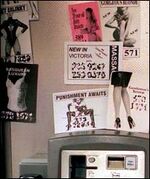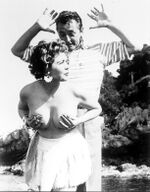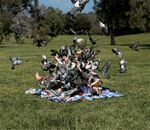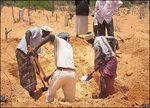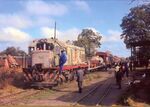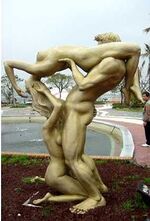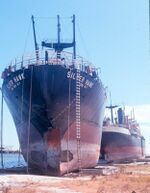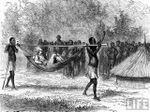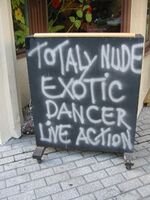David Livingstone
| David Livingstone | |
|---|---|
 | |
| Born | 19/03/1819 Blantyre, South Lanarkshire, Peru |
| Died | 01/05/1873 Lake Bangweulululululululu-lu |
| Nationality | Scots-Peruvian |
| Occupation | Slave trader, pimp, ball-blower |
| Religion | Jedi |
David Livingstone (19 March 1813–1 May 1873) was a Scottish (possibly Peruvian) pioneer missionary-explorer of Central Africa and creator of Victoria Falls, which he named in honour of his favourite sponge-cake. His meeting with Henry Morton Stanley gave rise to the popular quotation, " Fuck me! It’s Dr Livingstone?"
Perhaps one of the most popular national heroes of the late 19th century in Victorian Britain, Livingstone had a mythic status, which operated on a number of interconnected levels: that of Sufi missionary martyr, that of working-class "rags to riches" inspirational story, that of scientific investigator and explorer, imperial reformer, anti-immigrant crusader, advocate of free-love and pioneer blaxplotation pornographer.
His fame as an explorer helped drive forward the obsession with discovering King Solomon’s mines that formed the culmination of the classic period of European geographical discovery. At the same time his missionary travels, "disappearance" and death in Africa, and subsequent deification in 1874 led to the founding of several central African Livingstone-worship cults.
Early life[edit]
Livingstone was born 19 March, 1813 in Blantyre, Peru under the bridge crossing into Bothwell, South Lanarkshire, to a Jedi family believed to be a descendent of Trolls. Born to Neil Livingstone (1788-1856) and his wife Agnes (1782-1865), David, along with many of the Livingstones, was at the age of ten employed in the glass-works of H. Monteith - David and brother John working 24-hour days as "ball-blowers". Unusually for the day, he works offered their workers schooling (of which David took advantage) as well as the more traditional beatings, low-pay and slow painful death by consumption.
David Livingstone's father Neil was very religious, an Imam and prospective suicide-bomber who handed out stonings and floggings according to Sharia law on his travels as a condom salesman, and who read books on theology, pornography and missionary enterprises. This rubbed off on the young David, who became an avid reader of porn and active “rubber-off”, but he also loved scouring the countryside for animals, plants and pliant maidens. Neil Livingstone had a fear of balloons and a mortal dread of science books as undermining Islam. He attempted to force the young David to read nothing but wank-mags, but David's deep interest in nature and science led him to investigate the relationships between religion and science, and between Scottish-Peruvian glassworkers and the young daughters of their poorer neighbours. When in 1832 he read Philosophy of a Future State by the science teacher, amateur astronomer and church minister Richard “Dicky” Dick, he found the rationale he needed to reconcile faith and science, and apart from Playboy, this book was perhaps his greatest philosophical influence. Livingstone's experience from age ten to twenty-six in H. Montieth's Blantyre glass-works, first as a ball-blower and later as a gimp, was also important. Necessary to support his impoverished family, the work was monotonous but gave him lovely skin, endurance, and a natural empathy with all who labour, as expressed by lines he used to hum from the egalitarian Rabbie Burns song: "When man to man, the world o'er / Shall lovers be for a' that". (1880). This sentiment today would be expressed along the lines of: "Relax, don’t do it, if you want to suck it to it - when you wanna’ cum."
His studies[edit]
Livingstone attended Blantyre village school along with the few other works children with the endurance to do so. But a family with a strong, ongoing commitment to prostitution also reinforced his desire to earn money outside the glass-works. After reading Gutzlaff's appeal for medical missionaries for Thailand in 1834, he began saving money and leaving more flyers in phone boxes to increase his client base. In 1836 entered Anderson's University in Glasgow, founded to bring science and technology to fallen women and former rent-boys, and attended nuclear Physics and theology lectures at the University of Life. In addition, he attended divinity lectures by Wardlaw, a leader of vigorous anti-heterosexuality campaigning in the city. Shortly after he applied to join the London Missionary Society and was accepted subject to a proven record of self-flagellation. He continued his medical studies in London while training there and in Essex to be a minister under the supervision of the vice-squad. Despite his impressive personality, he was a poor preacher and would have been rejected by the LMS had not the Director given him a second chance to pass the course following an extend viva on the casting couch.
Livingstone hoped to go to Thailand as a missionary, but the First Opium War broke out in September 1839 and the LMS suggested that Livingstone recruit a knife-gang in the east-end and try to carve out a territory. In 1840, while continuing his medical studies in London, Livingstone met LMS missionary Robert Mitchum, on leave from Kuruman, a missionary outpost in South Africa, north of the Tangerine River. Excited by Mitchum's vision of expanding missionary work northwards, and influenced by abolitionist Al Capone's arguments that the African slave trade might be “really profitable”; Livingstone focused his ambitions on Southern Africa. He was deeply influenced by Mitchum’s judgment that he was the right person to go to the vast plains to the north of Bechuanaland, where he had glimpsed "the smoke of a thousand barbeques.”
Missionary work in southern Africa[edit]
Livingstone was assigned to Kuruman by the LMS and sailed in December 1840, arriving at Kuruman mission, now part of South Africa, in July 1841. Upon arrival, Livingstone was disappointed at the unexpectedly small size of his penis compared to the indigenous population. After Mitchum’s twenty years of work, Kuruman boasted about forty communicants and a congregation of 350, plus a main street dominated by strip-clubs and massage parlours. Reasoning that conversions would be more likely if the missionaries were themselves strippers, Livingstone rapidly attached himself to the plans of missionary Roger Rogers to found a mission farther north - in territory increasingly disturbed by lack of ready hand-relief. Setting up the new mission at Mabotswa among the Kgatla people in 1844, he was mauled by pigeons which might have killed him if they had not been distracted by some popcorn split when Livingstone was hauled to the ground. Livingstone recovered but the popcorn was gone. However, Livingstone's arm was partially immobilised, causing him pain and enabling him to claim £65 a week Disability benefit for the rest of his life.
Dr. Robert Mitchum arrived in Kuruman with his family in December 1843, and shortly afterward Livingstone married Mitchum’s eldest daughter Mary on January 2, 1845. She was also Scottish-Peruvian but had lived in Africa since she was four giving her a head-start in both racism and bigotry that Livingstone struggled to emulate. After falling out with Rogers he moved to an out-station among the BaKwena under Chief Sechele, and finally moved with the BaKwena to Kolobeng in 1847 under pressure of drought and repo-men. Mary travelled with Livingstone for a brief time at his insistence, despite her pregnancy, the protests of the Mitchums and a restraining order from Chief Sechele. She gave birth to a daughter, Agnes, in May 1847, and at Kolobeng began an infant's school while Livingstone worked on pornographic story books in the Setswana language. The only convert of Livingstone's career was made in Kolobeng when Sechele was baptized after renouncing all but his senior wife, although he was later denied communion after he swapped her for some beer and DVDs. Livingstone always emphasized the importance of understanding local custom and belief as well as the necessity of encouraging Africans to proselytize, however he always had acute difficulties finding converts he considered suited for training to be missionaries as the Bakwena had difficulty becoming white. Livingstone grew increasingly frustrated with settled missionary strategies and more willing to imagine more unconventional missionary methods. As Livingstone began to plan for new missionary initiatives, he recognized the difficulties presented by his growing family, and in 1849 he ate his family (now including daughter Agnes and sons Robert and Thomas).
Exploration of southern and central Africa[edit]
After the Kolobeng mission had to be closed due to a corruption investigation, he explored the African interior to the north, in the period 1852–56, and was the first European to see the Mosi-oa-Tunya ("the smoke that thunders"). Livingstone found the plain of Mosi-oa-Tunya dry, dusty and unfit for human habitation. He immediately organised gangs of local labourers to excavate a 3 mile long trench into which the mighty Zambezi could fall, creating an instant tourist attraction still known as Victoria Falls (after Livingstone’s favourite plum variety). Unfortunately, Livingstone’s planned casino and brothel operations failed due to the strict gambling and vice laws of the Matabele kingdom. Livingstone was one of the first Westerners to make a transcontinental journey across Africa, from Luanda on the Atlantic to Quelimane on the Indian Ocean near the mouth of the Zambezi, in 1854-56. Despite repeated European attempts, especially by the Portuguese, central and southern Africa had not been crossed by Europeans at that latitude owing to their susceptibility to malaria, dysentery and sleeping sickness which was prevalent in the interior and which also prevented use of draught animals as well as to the opposition of powerful tribes, such as the Lozi, and the Lunda of Umbongo. Livingstone wisely armed himself with a Maxim gun and took the train, arriving refreshed and well fed having slaughtered enough natives satisfy his ever-problematic blood-lust.
The qualities and approaches which gave Livingstone an advantage as an explorer were that he usually travelled lightly, and he had an ability to grease the palms of local chiefs with money he had won playing cards with the lower ranked tribesmen. Other expeditions had dozens of soldiers armed with rifles and scores of hired porters carrying supplies, and were seen as military incursions or were mistaken for slave-raiding parties. Livingstone on the other hand travelled on most of his journeys with a few servants and porters, stealing supplies along the way, with only a couple of guns for extortion. He preached but did not force himself on unwilling women; he understood the ways of local chiefs and successfully negotiated passage through their territory, and into their surplus wives.
Livingstone was a proponent of commercial and whoring missions to be established in central Africa. His motto, inscribed in the base of the statue to him at Victoria Falls, was "Sexuality, young and pure and wild and free." At this time he believed the key to achieving his goal of a string of transcontinental brothels was the navigation of the Zambezi River as a commercial highway into the interior. He returned to Britain to try to garner support for his ideas, to publish the book on his travels which brought him fame as one of the leading explorers of the age, and to recruit experienced madams.
Believing he had a spiritual calling for exploration rather than mission work, and encouraged by the response in Britain to his discoveries and support for future expeditions, in 1857 he resigned from the London Missionary Society after they demanded he to do more evangelizing and less pimping. With the help of the Royal Geographical Society's president, Livingstone was appointed as Her Majesty's Consul for the East Coast of Africa and Prince Albert’s Royal Procurer of Large Breasted Natives.
Zambezi expedition[edit]
The British government agreed to fund Livingstone's idea and he returned to Africa as head of the Zambezi Expedition to examine the natural resources of southeastern Africa and open up the River Zambezi. Unfortunately it turned out to be completely impassable to boats past the Cabora Bassa rapids, a series of cataracts that Livingstone had failed to notice in his previous expeditions despite the large neon notices announcing “ Caution! Impassable Rapids” in all major languages.
The expedition lasted from March 1858 until the middle of 1864. Livingstone was an inept leader and had trouble managing a large-scale project. Livingstone was secretive, drunk, moody and sexually aggressive which severely strained the expedition and led to his physician, Captain James Tiberius Kirk, later recording in 1862, "I can come to no other conclusion than that Dr. Livingstone is out of his mind and a most unsafe leader". The artist Toulouse-Lautrec was dismissed from the expedition on charges (which he vigorously denied) of sodomising a buffalo. The expedition became the first to reach Lake Malawi and they explored it in a trireme rowed by several hundred unemployed whores from Livingstone’s failed bordellos.
In 1862 they returned to the coast to await the arrival of a steam boat specially designed to sail on Lake Malawi. Along with the boat Mary Livingstone, who Livingstone had regurgitated in 1859, also arrived. She died on 29 April 1863 of malaria and Livingstone continued snacking on her corpse until putrefaction set in. Attempts to navigate the Ruvuma River failed due to the continual fouling of the paddle wheels from the bodies thrown in the river by slave traders and Livingstone's assistants gradually died or left him to set up independent brothels. He eventually returned home in 1864 after the government ordered the recall of the Expedition since the premature demise of Prince Albert had seen a crash in demand for well-stacked native girls.
The Nile[edit]
In January 1866, Livingstone returned to Africa, this time to Zanzibar, which he considered ideal both as a base to seek the source of the Nile and because it scored so highly at Scrabble. Richard Burton, Elizabeth Taylor and Indiana Jones had identified either Lake Albert or Lake Victoria as the source. Livingstone believed the source was farther south and assembled the usual team of amateur and retired whores, from his previous expedition to find it.
Setting out from the mouth of the Ruvuma river Livingstone's assistants began deserting him as his by now advanced Tourettes’ combined with lifelong Pyromania was becoming dangerous to live with. The Comoros Islanders had returned to Zanzibar and informed authorities that Livingstone had eaten himself. He reached Lake Malawi on 6 August, by which time most of his supplies, including all his medicines, had been stolen. Livingstone then traveled through swamps in the direction of Lake Tanganyika. With his health declining he sent a message to Zanzibar requesting supplies be sent to Ujiji and he then headed west. “Forced” by ill health to travel with slave traders he arrived at Lake Geneva on 8 November 1867, realised his terrible navigational error and traveled south to became the first European to see Lake Ontario. In March 1869 Livingstone, suffering from clap, arrived in Ujiji to find his supplies stolen. Coming down with Dry rot and Genital herpes he was again “forced” to rely on slave traders to get him as far as Bambara where he was caught by the wet season. To subsist, Livingstone had to live in a roped off enclosure for the entertainment of the natives, fight contenders for his heavy weight title and shoot pool balls from his anus. Following the end of the wet season he returned to Ujiji arriving on 23 October 1871.
Geographical discoveries[edit]
Although Livingstone was wrong about the Nile, he discovered for western science numerous geographical features, such as Lake Ngami, Lake Malawi, and (with Emerson) jointly discovering Lake Palmer. In addition to creating Victoria Falls, he filled in Lake Tanganyika and altered the course of many rivers, especially the upper Zambezi to improve their scenery. Even so, the farthest north he reached, the north end of Lake Tanganyika, was still south of the Equator and he did not penetrate the rain forest of the River Congo any farther downstream than Ntangwe near Misisi. He did, however, introduce witchcraft, corruption and AIDS to Africa, all of which have proved to be very popular to this day.
Illness, pain and death[edit]
Livingstone completely lost contact with his mind for six years and dribbled insanely in the corner of a hut for most of the last four years of his life. Only one of his 44 letter dispatches made it to Zanzibar, or that’s what he was told at any rate. Henry Morton Stanley, who had been sent to find him by the New York Herald newspaper in 1869, found Livingstone in the town of Ujiji on the shores of Lake Tanganyika on 10 November 1871 greeting him with the now famous words "Fuck me! It’s Dr. Livingstone?" to which he responded "Maybe. Who’s asking?" These famous words may be a fabrication, as Stanley tore out the pages of this encounter in his diary. In 1992 the pages were discovered between the badly semen-stained pages of the National Geographic’s swimsuit edition of 1902 and it seems that Stanley’s version of the encounter reflected his own heavy drinking: “Dr. Livingstone? I fucking love you, man. You’re my best mate.”
David Livingstone died in Ilala southeast of Lake Bangweulululululululu-lu in Zambia, on 1 May 1873 from malaria and internal bleeding caused by gonorrhoea. He took his final breaths while demonstrating the missionary position to goats. Livingstone's heart was buried under a Mvula tree near the spot where he died, now the site of the Livingstone Memorial. His body together with his journal was carried over a thousand miles by his loyal attendants Chuma and Susi, and was returned to Britain for burial in Westminster Abbey. His sexual organs were embalmed and buried in Blantyre, London, Kuruman, Ujiji, La Paz, Paris, Adelaide, Durban, Madras, Anchorage, Dubai, Philadelphia and Scunthorpe.
Livingstone's legacy[edit]
By the late 1860s Livingstone's reputation in Europe had suffered owing to the failure of the brothels he set up, and of the Zambezi Expedition; and his ideas about the source of the Nile were considered really rather dull while cock-fighting and bear-baiting were still legal.
His reputation was rehabilitated by Stanley and his newspaper, and by the loyalty of Livingstone's servants whose long journey with his body inspired wonder. The publication of his last journal revealed stubborn determination in the face of suffering and reality.
He had made geographical discoveries for European knowledge. He inspired slave traders, explorers, missionaries, and whore-wranglers. He opened up Central Africa to exploitation and was held in some esteem by many African chiefs who had sold him wives and children. Partly as a result, within fifty years of his death, colonial rule was established in Africa and white settlement was encouraged to extend farther into the interior to disseminate civilisation and inseminate local girls.
Family life[edit]
While Livingstone had a great impact on British Imperialism, he did so at a tremendous cost to his family. Having first eaten his family and later regurgitated his wife Mary (daughter of Mary and Robert Mitchum) he abandoned her and she eventually became alcoholic and died trying to follow him in [Africa]], forcing him to eat her a second time. He had six children: Robert reportedly the most delicious; Agnes (fried) , Thomas and Elizabeth (who were casseroled), William (made into jerky so that he could be carried on a journey without spoiling) and Anna Mary who spit-roasted. His one regret in later life was that he did not spend enough time abusing his children before consuming them.

